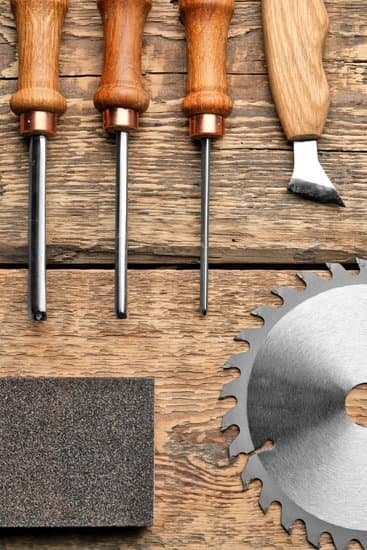What is a shaper for woodworking? A woodworking shaper is a specialized power tool used to create various shapes, designs, and cuts in wood. This versatile machine is essential for professional woodworkers and hobbyists alike, allowing them to achieve precision and intricacy in their projects that may not be possible with other tools.
Woodworking shapers have a rich history and have evolved over time to become more efficient and user-friendly. From manual shapers to the modern computer-aided ones, these tools have come a long way in providing woodworkers with the flexibility and control they need to bring their creative visions to life.
In this article, we will delve into the world of woodworking shapers, exploring their history, different types available, key components, types of cuts and shaping achievable, safety precautions, tips for selecting the right shaper for your needs, as well as maintenance and care best practices. Whether you are new to woodworking or looking to expand your knowledge on these powerful machines, this comprehensive guide will provide you with valuable insights into the world of woodworking shapers.
The History and Evolution of Woodworking Shapers
Woodworking shapers have a rich history that dates back to the early 19th century, where they were first introduced as hand-operated machines. These early shapers were primarily used for basic shaping and moulding of wood, and their design was simple compared to modern woodworking shapers. Over time, advancements in technology and engineering led to the development of more sophisticated and powerful woodworking shapers that are commonly used today.
One significant milestone in the evolution of woodworking shapers was the introduction of power-driven shapers in the late 19th century. This innovation revolutionized the woodworking industry by significantly increasing productivity and efficiency. Power-driven shapers allowed woodworkers to achieve more intricate and detailed designs with greater precision, paving the way for new possibilities in woodworking craftsmanship.
As the demand for customization and specialization in woodworking grew, so did the variety of woodworking shapers available on the market. Today, woodworkers can choose from a range of different types of shapers, including spindle shapers, overhead pin routers, and power feeder shapers, each designed to cater to specific shaping needs. The evolution of woodworking shapers continues as new technologies emerge, offering woodworkers even more advanced features and capabilities.
| Woodworking Shaper Type | Description |
|---|---|
| Spindle Shaper | A stationary woodworking machine with a vertically oriented spindle mounted on an adjustable table. |
| Overhead Pin Router | Utilizes a high-speed rotating cutter that is suspended from a pivoting arm. |
| Power Feeder Shaper | Equipped with power feeders to assist in moving material through the cutting head. |
Different Types of Woodworking Shapers and Their Functions
Woodworking shapers come in various types, each designed for specific functions and purposes. Understanding the different types of woodworking shapers can help woodworkers choose the right tool for their projects.
Spindle Shapers
One of the most common types of woodworking shapers is the spindle shaper. This type of shaper features a vertical spindle onto which cutter heads are attached. Spindle shapers are ideal for creating decorative moldings, tenons, and other intricate shapes on wood.
Power Shapers
Power shapers are similar to spindle shapers but operate using a horizontal spindle instead of a vertical one. They are often used for larger scale woodworking tasks and have the ability to accommodate multiple cutter heads simultaneously.
Router Shapers
Router shapers combine the functions of a router and a shaper, allowing woodworkers to utilize both tools in one machine. These versatile machines are suitable for smaller scale projects and can perform a wide range of shaping and cutting tasks.
Understanding the different types of woodworking shapers and their functions is essential for selecting the right tool for your specific woodworking needs. Whether you need to create intricate moldings or perform larger scale shaping tasks, there is a woodworking shaper available to meet your requirements.
Key Components of a Woodworking Shaper
Woodworking shapers are powerful machines that are essential for creating smooth and precise cuts, edges, and profiles in wood. Understanding the key components of a woodworking shaper is crucial for users to operate the machine safely and effectively. Below are the main components of a woodworking shaper:
1. Motor: The motor is the heart of a woodworking shaper, providing the power needed to spin the cutting tools at high speeds. It is important to consider the motor’s horsepower and speed capabilities when selecting a shaper for specific woodworking projects.
2. Spindle: The spindle is the rotating shaft on which the cutting tool is mounted. Woodworking shapers can have different spindle sizes and configurations, such as vertical or horizontal spindles, allowing for versatility in shaping options.
3. Fence: The fence of a woodworking shaper serves as a guide for the wood being shaped, ensuring straight and accurate cuts. Some fences are adjustable to accommodate various angles and shapes.
4. Cutting tools: Woodworking shapers use a variety of cutting tools, including router bits, molding heads, and shaping knives. These tools are attached to the spindle and come in different shapes and sizes to achieve specific cuts and profiles.
5. Dust collection system: A dust collection system is an important component for maintaining a clean working environment while using a woodworking shaper. It helps remove sawdust and debris generated during the shaping process, improving visibility and safety.
Understanding these key components will help users maximize the capabilities of their woodworking shapers while maintaining safety standards and achieving high-quality results in their projects.
Types of Cuts and Shaping That Can Be Achieved With a Woodworking Shaper
A woodworking shaper is a versatile tool that allows woodworkers to create various cuts and shapes on different types of wood. Whether you are looking to create intricate designs, moldings, or joints, a woodworking shaper can help you achieve your desired results. Here are the different types of cuts and shaping that can be achieved with a woodworking shaper:
- Straight Cuts: A woodworking shaper can be used to make straight cuts on wood, which is essential for creating clean edges and smoothing out rough surfaces.
- Curved Cuts: With the appropriate cutter head and setup, woodworking shapers can produce curved cuts, allowing woodworkers to create unique designs and patterns on their projects.
- Edge Profiles: Woodworking shapers are ideal for creating various edge profiles, such as roundovers, chamfers, ogees, and more. This adds decorative elements to furniture pieces and other woodworks.
In addition to the types of cuts mentioned above, a woodworking shaper can also be used for shaping joinery and adding details like fluting or reeding to wooden surfaces. When equipped with the right cutting tools and accessories, a woodworking shaper opens up numerous possibilities for woodworkers to unleash their creativity and craftsmanship.
Woodworking shapers come in various sizes with different motor powers which determine the type of work they are best suited for. Understanding the capabilities of each type of woodworking shaper is important when considering the types of cuts and shaping you want to achieve in your projects. It’s also important to note that using this tool requires proper knowledge of its operation as well as safety precautions.
Safety Precautions and Best Practices When Using a Woodworking Shaper
When it comes to using a woodworking shaper, safety should always be the top priority. The spinning blades and powerful motor of a woodworking shaper can present serious hazards if not used properly. It is important to always wear appropriate safety gear, including eye protection, ear protection, and proper clothing. It is also essential to keep the work area clean and free of any obstacles that could cause accidents.
In addition to safety gear and a clean work area, it is crucial to follow best practices when using a woodworking shaper. This includes carefully planning your cuts and measurements before turning on the machine. Always use sharp blades and cutters, as dull tools can lead to kickback and other dangerous situations. It is also important to feed the material through the shaper at a consistent rate, avoiding any sudden movements that could cause jamming or kickback.
Furthermore, it is recommended for woodworkers to undergo training or seek guidance from experienced individuals before using a woodworking shaper for the first time. Understanding the proper techniques for feeding material into the machine and making adjustments will go a long way in ensuring safe and successful operation of the woodworking shaper.
| Woodworking Shaper Safety Tips | Best Practices for Using Woodworking Shapers |
|---|---|
| Wear appropriate safety gear | Plan your cuts and measurements carefully |
| Keep work area clean and free of obstacles | Use sharp blades and cutters |
| Seek guidance from experienced individuals | Feed material through at consistent rate |
Tips for Selecting the Right Woodworking Shaper for Your Needs
When selecting a woodworking shaper for your needs, there are several factors to consider that will help you make the right choice. These machines come in various sizes and with different features, so it’s important to understand what you need before making a purchase. Here are some tips to help you select the right woodworking shaper for your specific requirements.
Consider Your Woodworking Projects
The first thing to consider when selecting a woodworking shaper is the type of projects you will be working on. If you typically work on smaller pieces, a smaller shaper may be sufficient. However, if you work on larger projects, you may need a larger, more powerful shaper to handle the workload. Understanding the scale of your projects will help you determine the size and power capabilities needed for your woodworking shaper.
Assess Your Budget
Woodworking shapers come in a wide range of prices, so it’s important to assess your budget before making a purchase. Consider how much you are willing to invest in a woodworking shaper and look for options within that price range. Keep in mind that while it’s important to stay within budget, quality should not be compromised. Look for a balance between affordability and functionality when selecting a woodworking shaper.
Research Different Brands and Models
Before making a final decision, take the time to research different brands and models of woodworking shapers. Read reviews from other woodworkers, compare features and specifications, and consider the reputation of the manufacturer. This research will give you insight into which woodworking shaper best suits your needs and which one offers the best value for your money. By taking these factors into consideration, you can make an informed decision when choosing a woodworking shaper for your workshop.
Maintenance and Care of a Woodworking Shaper
A woodworking shaper is a crucial tool in any woodworker’s arsenal, allowing for precise shaping and molding of wood. However, like any other tool, proper maintenance and care are essential to ensure its longevity and optimal performance.
To maintain a woodworking shaper, it is important to regularly clean the machine after each use. Sawdust and debris can accumulate in the machinery, affecting its performance over time. Additionally, it is important to check and replace any worn-out or damaged parts to prevent further damage to the machine.
Regular lubrication of moving parts is also crucial in maintaining the woodworking shaper. This includes the spindle, bearings, and any other moving components. Using the recommended lubricant will help reduce friction and wear on these parts, ultimately prolonging the life of the machine.
When not in use, it is important to store the woodworking shaper in a clean and dry environment. This will prevent rusting and corrosion of metal parts, as well as protect it from dust and other contaminants that could affect its performance.
Proper care and maintenance of a woodworking shaper not only ensures its longevity but also contributes to achieving optimal results in woodworking projects. By following these maintenance practices, woodworkers can continue to enjoy the benefits of using a woodworking shaper for years to come.
Conclusion
In conclusion, the use of a woodworking shaper in your woodworking projects can bring numerous benefits. The precision and efficiency that a shaper offers when creating intricate cuts and shaping wood are unmatched. The ability to replicate designs with ease and consistency makes this tool a valuable addition to any woodworker’s arsenal.
Furthermore, the evolution of woodworking shapers has made them more versatile and user-friendly than ever before. With different types of shapers available in the market, woodworkers have the ability to choose the right one for their specific needs, whether it’s for hobbyist projects or professional woodworking ventures.
Additionally, the safety precautions and best practices outlined for using a woodworking shaper ensure that woodworkers can operate this powerful tool with confidence. When maintained properly, a woodworking shaper can provide years of reliable service, making it a long-term investment for any woodworking enthusiast or professional. Overall, integrating a woodworking shaper into your workflow can streamline your woodworking processes and expand the possibilities of what you can achieve in your projects.
Frequently Asked Questions
Is a Shaper Just a Big Router?
A shaper is not just a big router. While both tools are used for shaping wood, they differ in their size, power, and the type of cut they produce. Shapers are typically larger and more powerful than routers, making them better suited for heavy-duty shaping tasks such as creating moldings and profiles.
What Is the Difference Between a Shaper and a Jointer?
The main difference between a shaper and a jointer lies in their intended use. A jointer is primarily used for flattening and straightening the edges of boards, while a shaper is designed for shaping the edges or surfaces of wood using profiled cutters or bits.
What’s the Difference Between a Shaper and a Router Table?
When comparing a shaper to a router table, the key difference lies in the size and power of each tool. Shapers are larger and more powerful than router tables, allowing them to handle heavier loads and cutters designed for industrial or heavy-duty woodworking applications.
In contrast, router tables are generally smaller and more suitable for smaller scale DIY or hobbyist woodworking projects.

Hi everyone! I’m a woodworker and blogger, and this is my woodworking blog. In my blog, I share tips and tricks for woodworkers of all skill levels, as well as project ideas that you can try yourself.





